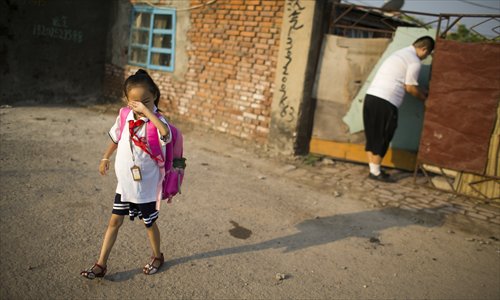Patient in a million

Han Shuo leaves her home for school as the new semester begins in September. Photo: Li Hao/GT
Eight-year-old Han Shuo looks no different from any other young child. She is quiet, loves reading, doing origami and watching singing competitions on TV.
However, she never takes part in sports at school, has to be extremely careful when climbing stairs, and when she has nosebleeds, it takes more than three hours to stop.
When she stands, even her ankle-length cotton dress can't hide the fact that her belly has swollen up like a pregnant woman's: her spleen is almost 40 times the normal size.
"She had wanted to become a doctor when she grows up, but the doctor said there's a possibility she won't live past 8 or 9," Han Shuo's father Han Qi said.
Han Shuo, living in Tianjin, was diagnosed with Gaucher's disease in 2009, a genetic disease that makes an enzyme defective and causes a fatty substance to accumulate in cells and organs. In Han's case, it makes her anemic, enlarges her spleen and obstructs her skeletal growth.
Enzyme replacement therapy is the only method to reduce the size of her spleen and keep her blood level stable, but the medicine costs about 2 million yuan ($329,456) per year.
Gaucher's disease is categorized as a "rare disease." According to the World Health Organization, a rare disease is one that affects a small percentage of the population, ranging from 0.65 to 1 in 1,000. However, China does not have a clear definition of a rare disease. Moreover, the medicine developed to treat these diseases - often known as "orphan drugs" - are too expensive for patients, and sometimes not produced because of low profit margins.
Activists are pushing to get these orphan drugs included in national medical insurance and trying to make rare diseases more known to the public. Meanwhile, patients like Han are still faced with a dilemma.

Han Shuo's mother Kang Changxia attends to her bleeding nose. Photo: Li Hao/GT
Treatment dilemma
Han Qi first realized something was wrong with his daughter in 2009. Han Shuo's uncle was playing with her and felt a hard lump under her rib, where her spleen was.
Worried, Han Qi took her to a local hospital in Ji'nan, Shandong Province, and later in Beijing. The results shocked him.
"The examination report said she had Gaucher's disease. We had no idea what that was, but the doctor told me it was really bad. It's an extremely rare disease," he said. "There's no good cure for it."
There's no clear definition of what a rare disease is or how many rare disease patients there are in China right now, said Han Jinxiang, Party secretary of the Shandong Academy of Medical Sciences. However, research is being done to expand the amount of scientific and official data.
On February 28, 2013, 17 medical institutions from 13 provinces launched the China Rare diseases Prevention and Treatment Alliance, China's first national organization against rare diseases.
Han Jinxiang, who is also the deputy director of the alliance, said the organization will assist in data collection of rare diseases, carry out epidemiological studies and improve treatment. One current project is conducting research into how many types of diseases can be considered rare, he said.
There are more than 6,000 rare diseases defined internationally, but treatment and medicine exists for only about 1 percent of them. Of these treatable diseases, China has almost no domestically produced medicine, Han said.
"There are few rare disease patients in China and the government doesn't have any policy subsidizing the production of rare disease medicine, so the pharmaceutical companies don't have any interest in producing such drugs," Huang Rufang, president of the grass-roots Chinese Organization for Rare Disorders, said.
Because of their specialist nature, some countries have a "green channel" for the examination and approval of those drugs. In the US, the Food and Drug Administration has an Office of Orphan Products Development, whose mission is to "advance the evaluation and development of products that demonstrate promise for the diagnosis and/or treatment of rare diseases or conditions." The office also provides incentives for sponsors to develop products for rare diseases.
However, the lack of such a mechanism in China directly results in these drugs being imported from abroad and means they usually aren't covered in national medical insurance. There is no way families like Han's can afford it.

Han Shuo plays with her 11-month-old brother Han Bokang at home. Photo: Li Hao/GT
Awareness neededAnother issue facing rare disease patients is that the disease is not well-known, Han said.
According to Han's rough estimates, before being officially diagnosed, 30 percent of rare disease patients need to see 5 or 10 doctors, nearly half are misdiagnosed with some other disease and 75 percent cannot receive scientific, regulated treatment plans.
For Gaucher's disease, the treatment plan is still being developed.
Song Xiaofang's daughter, 4-year-old Cao Linfei, was also diagnosed with Gaucher's disease in 2012. Cao had come to within inches of death at the beginning of 2013, and the doctor at the Naval General Hospital in Haidian district suggested hemopoietic stem cell transplant.
For a brief six-month period, Cao was China's first successful case of hemopoietic stem cell transplant being used to combat Gaucher's disease, after her operation in April. However, in October, her blood platelet level came down again.
The parents, who had already spent 600,000 yuan on the treatment, are baffled. Zhang Bo, Cao's clinical doctor, said that the symptoms she's showing are a complication from the transplant, but he can't be absolutely certain whether she can recover again.
When Han Qi was informed of Cao's condition, he gave up on the idea of letting Han Shuo go through with a transplant. An operation may not work so well and drugs are too expensive, so the only treatment Han Shuo is getting right now is blood transfusion and calcium pills, but that is only a superficial cure.
"At the beginning I often felt I was alone," the father said. "I had nobody to talk to about this disease and I couldn't see how she would get the treatment."
Existing networks
"The help rare disease patients receive usually comes from grass-roots organizations or other patients of these diseases," Huang said. "On the Internet, our organization has put in touch about 20,000 people suffering from 33 different diseases. But that's still a small number."
In recent years, a number of organizations were established, such as the Hemophilia Association of China, PKU Union, LAM China and albinism.org. In 2010, a foundation was set up at the Peking Union Medical College Hospital to support the patients of LAM/TSC, a rare disease that destroys lung tissue and prevents free flow of air.
Some of the organizations were started up by people suffering the disease. Wang Yiou, a patient of osteogenesis imperfecta, commonly known as brittle bone disease, started the China-Dolls Center for Rare diseases in 2007.
Her colleague, Xiao Lei, told China Fortune in a 2011 article that patients of rare diseases often thirst for more understanding and communication from peers.
"We now support more than 200 patient organizations for rare diseases in the country, whether it's through Internet forums, QQ chat groups or any other way. Patient organizations have provided a platform for information exchange and emotional support for rare disease patients," he said.
In Cao Linfei's case, the patient organization and rare disease foundation also provided financial support. Song received 200,000 yuan, which enabled her to pay for her daughter's operation.
Pushing for change
Li Dingguo, director of the rare disease branch of the Shanghai Medical Association, has been pushing for the definition and treatment of rare diseases to be included in legislation, and for the cost of treatment to be covered by medical insurance.
"Many treatments for rare diseases are not included in the national medical insurance, and some treatments can cost as much as 200,000 yuan a month," he said.
There have been successful cases, Huang explained. In 2011, the Shanghai government approved a proposal to cover the treatment cost in the children's medical cooperation fund, providing up to 100,000 yuan per year for children with four rare diseases, including Gaucher's disease. The limit was raised to 200,000 yuan in 2012.
The government of Qingdao, Shandong Province, also approved a proposal in 2012 that covers the treatment cost of all diseases including rare diseases for up to 400,000 yuan in the national medical insurance.
Hemophilia is a disease covered widely by national medical insurance to different degrees across China. Liu Xiaoguang, the director of the rehabilitation association of hemophilia, told Caixin that since 2005, hemophilia patients have been demanding the inclusion of the disease in national medical insurance.
Li suggests first starting with certain diseases in fixed cities, such as Beijing or Shanghai.
"There are about 6,000 rare diseases, but only about 60 are treatable, which means that if the patients take lifelong doses of medicine, they can be almost the same as normal people," Li said. "We are pushing to get these diseases covered."
Moreover, only when rare diseases and treatments are clearly defined can medical aid proposals be approved. Right now, Li and his colleagues are working on providing a clear definition in the medical community so that there can be direct policy generated, he said.
"Many people with rare diseases are dying every day. This cannot wait," he said. "They cannot afford to wait."
Han Qi's only wish is to be able to raise enough money to support Han Shuo for a year, or even just for a couple months.
"I want to get her treatment for a couple months and at least reduce the size of her spleen to normal," he said. "Even if I can't afford to pay for her drugs for life, at least this will add a transitional period."